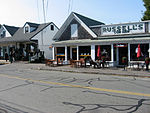Thornton W. Burgess Museum
Thornton W. Burgess Museum was a museum in East Sandwich, Massachusetts dedicated to the conservationist and children's book author Thornton W. Burgess (1874–1965). It was founded in 1974.The museum was based in a Colonial-style house on Shawme Pond (the model for the "Smiling Pool" in Burgess's stories). Burgess never lived in the house, but it was owned by one of his aunts. Burgess was particularly known for writing Peter Rabbit stories, following the model of Beatrix Potter, and the Peter Rabbit character was prominently featured on the property. The site also included a small library, an art gallery, and a jam shop.The museum is reported closing as of 2013 due to lack of funds to acquire and maintain the property.
Excerpt from the Wikipedia article Thornton W. Burgess Museum (License: CC BY-SA 3.0, Authors).Thornton W. Burgess Museum
Water Street,
Geographical coordinates (GPS) Address Website Nearby Places Show on map
Geographical coordinates (GPS)
| Latitude | Longitude |
|---|---|
| N 41.757 ° | E -70.5 ° |
Address
Deacon Eldred House
Water Street 4
02563
Massachusetts, United States
Open on Google Maps








